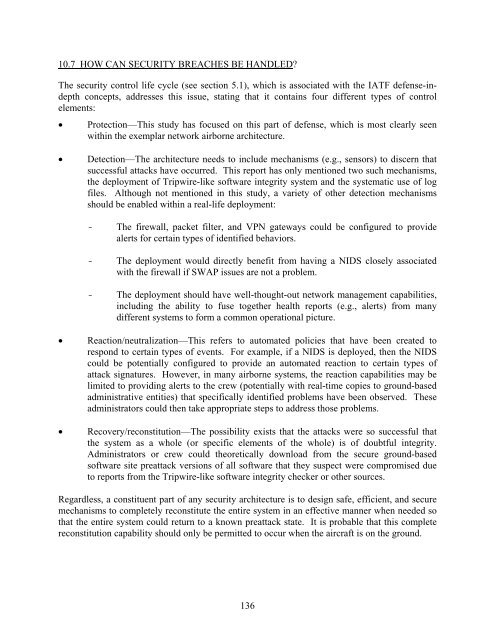Local Area Networks (LANs) in Aircraft - FTP Directory Listing - FAA
Local Area Networks (LANs) in Aircraft - FTP Directory Listing - FAA
Local Area Networks (LANs) in Aircraft - FTP Directory Listing - FAA
You also want an ePaper? Increase the reach of your titles
YUMPU automatically turns print PDFs into web optimized ePapers that Google loves.
10.7 HOW CAN SECURITY BREACHES BE HANDLED?<br />
The security control life cycle (see section 5.1), which is associated with the IATF defense-<strong>in</strong>depth<br />
concepts, addresses this issue, stat<strong>in</strong>g that it conta<strong>in</strong>s four different types of control<br />
elements:<br />
• Protection—This study has focused on this part of defense, which is most clearly seen<br />
with<strong>in</strong> the exemplar network airborne architecture.<br />
• Detection—The architecture needs to <strong>in</strong>clude mechanisms (e.g., sensors) to discern that<br />
successful attacks have occurred. This report has only mentioned two such mechanisms,<br />
the deployment of Tripwire-like software <strong>in</strong>tegrity system and the systematic use of log<br />
files. Although not mentioned <strong>in</strong> this study, a variety of other detection mechanisms<br />
should be enabled with<strong>in</strong> a real-life deployment:<br />
- The firewall, packet filter, and VPN gateways could be configured to provide<br />
alerts for certa<strong>in</strong> types of identified behaviors.<br />
- The deployment would directly benefit from hav<strong>in</strong>g a NIDS closely associated<br />
with the firewall if SWAP issues are not a problem.<br />
- The deployment should have well-thought-out network management capabilities,<br />
<strong>in</strong>clud<strong>in</strong>g the ability to fuse together health reports (e.g., alerts) from many<br />
different systems to form a common operational picture.<br />
• Reaction/neutralization—This refers to automated policies that have been created to<br />
respond to certa<strong>in</strong> types of events. For example, if a NIDS is deployed, then the NIDS<br />
could be potentially configured to provide an automated reaction to certa<strong>in</strong> types of<br />
attack signatures. However, <strong>in</strong> many airborne systems, the reaction capabilities may be<br />
limited to provid<strong>in</strong>g alerts to the crew (potentially with real-time copies to ground-based<br />
adm<strong>in</strong>istrative entities) that specifically identified problems have been observed. These<br />
adm<strong>in</strong>istrators could then take appropriate steps to address those problems.<br />
• Recovery/reconstitution—The possibility exists that the attacks were so successful that<br />
the system as a whole (or specific elements of the whole) is of doubtful <strong>in</strong>tegrity.<br />
Adm<strong>in</strong>istrators or crew could theoretically download from the secure ground-based<br />
software site preattack versions of all software that they suspect were compromised due<br />
to reports from the Tripwire-like software <strong>in</strong>tegrity checker or other sources.<br />
Regardless, a constituent part of any security architecture is to design safe, efficient, and secure<br />
mechanisms to completely reconstitute the entire system <strong>in</strong> an effective manner when needed so<br />
that the entire system could return to a known preattack state. It is probable that this complete<br />
reconstitution capability should only be permitted to occur when the aircraft is on the ground.<br />
136
















